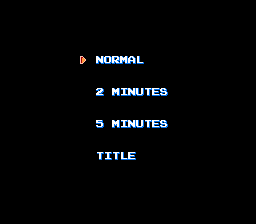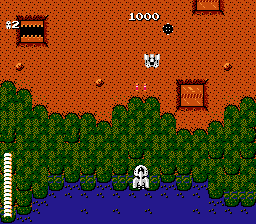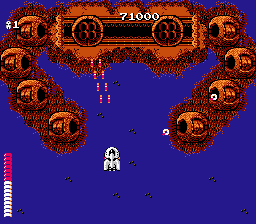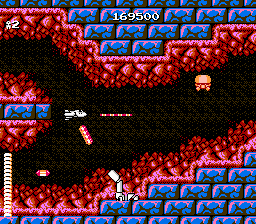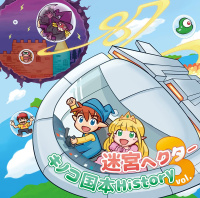Starship Hector (NES)
| Starship Hector | ||||||
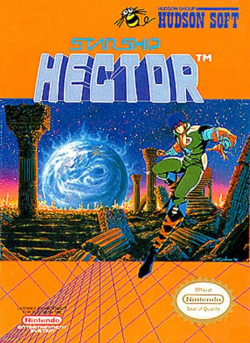 |
||||||
| ||||||
Starship Hector (released originally in Japan as Hector '87) is a space-themed shooter developed and published by Hudson Soft. It is the Star Year of 2038, and there was a fourth world war which destroyed all mankind on earth. Many light years away, the Starship Hector was on a voyage, and when it visited the earth, it was found to have been inhabited by evil bio-mechanical beings. In this game, your goal is to get through all 6 stages (called History). The odd-numbered stages are played from a top-down vertical perspective, while the even-numbered stages are played from a side-scrolling perspective (similar to the likes of Silver Surfer. You take on the role of the Starship Hector (presumably the pilot or captain) and have two attacks, both of which are unlimited; A fires your lasers (dubbed Sparkle Gun in the game's manual) while B drops bombs (the manual calls them Craster Bombs) down towards ground objects, similar to Xevious. At the end of each "History" is a boss that must be defeated to proceed.
Though the game only has 6 stages and starts you with 16 health points, the game is very difficult; Almost all the time, there are several projectiles on the screen, most of which can deplete a lot of your energy. Also, in the sidescrolling levels, touching the walls, fire, and even some enemies can kill you in one hit. Using a turbo controller does little to help since the game limits the amount of shots on the screen. On top of that, there are no continues. However, if the player manages to beat the game and starts again without turning off the console, they will unlock a robot as the player character. However, this only serves as a cosmetic change and doesn't have any advantages over the Starship Hector.
Starship Hector also offers a 2-minute and 5-minute play mode, in order to keep score of how many points the player can earn within the given time limit. As a part of the Caravan series by Hudson in Japan, prizes were awarded to contestants who got the highest scores; One first prize winner would receive a CD player, three second prize winners would receive a Famicom Twin by Sharp, and ten third prize winners would receive 10 videotapes by TDK.
The game was later released for the Super Famicom as part of a compilation cartridge called Caravan Shooting Collection (SFC), as well as a Game Boy Advance compilation called Hudson Best Collection Vol. 5: Shooting Collection (GBA). The graphics and sound were slightly touched up, but the game is mostly like the NES version.
Contents
Screenshots
Music
The game has a few in-game tunes. Each one is lengthy, so they don't get annoying quick. A lot of the soundtrack, as usual with the composer, Takeaki Kunimoto's style, features elements of jazz.
Takeaki wrote his music on the MSX computer using his Yamaha sequencers. The sequence files and demo tapes were then sent to Hudson Soft to implement into the game. It is most likely the game's sound designer Toshiaki Takimoto was responsible for the arrangements. Toshiaki most likely implemented the music in either 6502 assembly or a form of Music Macro Language, as was the standard for making NES music. Takimoto also arranged Kunimoto's music for the PC Engine title Break In.
The song names were originally taken from the SPC rip of the Caravan Shooting Collection. However, while that game sports one unused song, the NES version has two. While the songs are used in-game, they are missing their intros, so these variants go unused. They were probably meant to play after the player loses a life and restarts the stage.
The songs have been retitled and reordered after the titles found in the CD Kinoko Kunimoto Takeaki History Vol.3: Meikyuu Hector. However, this CD lacks the boss music. Fortunately, a previous soundtrack CD, Famicom 20th Anniversary Original Sound Tracks Vol. 2, features all the songs and titles it Boss. The two CDs share the same names and ordering of the tracks regardless. However, the latter CD has a track for the staff roll, but this is simply the History 1 music.
According to Takimoto, he once demonstrated the game in a shop to advertise and promote sales of the game. However, he wasn't very good at the game and the kids laughed at him.
Recording
| # | Title | Composer | Length | Listen | Download |
|---|---|---|---|---|---|
| 01 | Title | Takeaki Kunimoto | 0:20 | Download | |
| 02 | History 1 | Takeaki Kunimoto | 2:15 | Download | |
| 03 | History 2/4/6 | Takeaki Kunimoto | 1:46 | Download | |
| 04 | History 3/5 | Takeaki Kunimoto | 2:53 | Download | |
| 05 | Hector Bonus | Takeaki Kunimoto | 2:56 | Download | |
| 06 | Boss | Takeaki Kunimoto | 0:53 | Download | |
| 07 | Stage Clear | Takeaki Kunimoto | 0:05 | Download | |
| 08 | Game Over | Takeaki Kunimoto | 0:20 | Download | |
| 09 | Ending | Takeaki Kunimoto | 0:59 | Download | |
| 10 | Unused Song 1 | Takeaki Kunimoto | 2:12 | Download | |
| 11 | Unused Song 2 | Takeaki Kunimoto | 2:50 | Download |
Credits
- Ripper:
- Recorder: Doommaster1994
- Game Credits:
- Sound Designer: Toshiaki Takimoto
- Music: Takeaki Kunimoto credited as Kinoko Kunimoto
- Uncredited Sound Driver: Fumihiko Itagaki
The credits can be seen after beating the game. Both the US and Japanese versions have the same credits.
We asked Toshiaki Takimoto about the sound engine's programmer. Though he knew who it was, he declined to answer, but said that the sound engine could easily be modified for each game it was used in. Looking at the game's audio code, it appears to be based on Hudson's primary sound engine by Fumihiko Itagaki, though Itagaki said he did not provide the game's sound engine. It is possible that one of the developers, either the programmer or Takimoto made the modifications.
Toshiaki Takimoto may have possibly arranged Kunimoto's music for the NES, as he arranged Kunimoto's music for the PC Engine games Break In and Yuuyuu Jinsei, so he may have also been responsible for this game's arrangements, but verification should be made.
The game was ported to the Super Famicom in Caravan Shooting Collection (SFC) and the Game Boy Advance in Hudson Best Collection Vol. 5: Shooting Collection (GBA), and as a result, uses the same exact credits. However, the original staff did not work on these, and were most likely arranged by an uncredited developer.
This was also the first game to credit Kunimoto.
Albums
Game Rip
Audio Devices
The game uses the RP2A03 of the NES. It uses one of Hudson Soft's many sound drivers.
Releases
| ||||||||||||||||||||||||
Links
- gamefaqs.gamespot.com/nes/587652-starship-hector - GameFAQs.
- mobygames.com/game/nes/starship-hector - MobyGames.
- w.atwiki.jp/gamemusicbest100/pages/1020.html - Atwiki.jp (Japanese).

